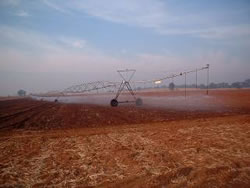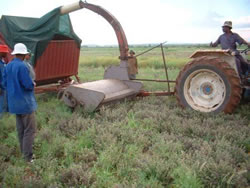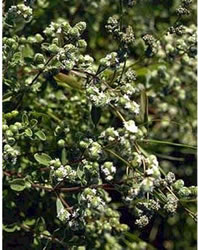Agronomical factors
Upright growth ( i.e. weed free - to avoid extract contamination). Quick development young plants (especially for marjoram which is a slowly establishing crop and is rather weak when facing weed problems). Resistance to pathogens (for example O. marjorana is severely affected by Alternaria and Fusarium) salt and drought tolerance. Perennial - plants live for some 7 productive years - yields increase significantly after 1st year's harvest.
Uses
Hay fever, sinus congestion, indigestion, asthma, stomach pain, and nervous disorders. It is highly fragrant and calming herb that has a mild anti oxidant, anti fungal and anti-spasmodic properties. The dried leaves of sweet marjoram are widely used by food industry as flavouring agents for dressing, soups, and in formulation of vermouth and bitters.The (volatile) extract is known for its antibacterial, anti fungal, and antioxidant properties.
Planting

When direct planting takes place, with a fine seed planter, light soil, drained soils with the pH of approximately 6.9 are essential. When grown near stinging nettle, marjoram scent are appears to become stronger. Distances of 30cm between rows are advised to permit hoeing and mechanical weeding. Plant density influences the yield and the weight of the plant.
Germination takes 8-10 days. Take care that the soil is well drained as the germination process is difficult. Direct seeding with a fine seed planter depositing about 100 seed per square meter. The depth of sowing is 0-5mm. The temperature of germination proved optimum values at 15C and 35 C. The most delicate time during this crop cultivation is the seed germination stage. Most damage during the whole period occurs during this time, fungal diseases and bad weather conditions (heavy rainfall, or hot and dry periods) being hazardous to this crop. 5 mm of irrigation in the morning and late afternoon gave the best germination of about 85%. The germination rate is particularly fast and shows 50% germination (at optimum conditions) within 2 days while germination complete within a week.
Growing

Normally, Marjoram is cultivated in dry climatic conditions. To increase the yield to obtain a second cutting in autumn it is necessary to irrigate during the summer, soon after the cutting. It is also advisable to irrigate the crop in spring if there has been no rain over a long period during the winter.
It is noted that when watering, it is better to give less water more often i.e. rather water twice a day at 5 mm per watering than one watering at 15 mm per day. The marjoram will "disappear" when the 1st 3-5mm of soil surface is dry. The best germination conditions are achieved by applying a thin layer of organic matter (mulch) about 5 to 15 mm in thickness (cut grass or wheat sticks at about 15-20cm in length) on the planted area. This serves as a buffer to the heat of the sun and avoids drying out of the soil surface. During strong summer thunderstorms when the rain drops are big the erosion and flooding of soil surface is also minimized because of mulch layer.
Weed Control
Selective herbicides are also available for post-transplanting: phenmedipham (application rate 1 kg/ha), alloxydim-sodium (0.7 kg/ha). However, it is necessary to have mechanical weed control.
Watering Schedule
| Time | Pivot % | How Long? |
| 1st week (7days) Continue until germination | 100%, 5-7 ml | 1st irrigation after planting, 2-3 times/day |
| 2nd and 3rd week (14-21 days) | 80-100% 10 ml wet in the ground | Keep soil surface moist to avoid drying out |
| 4th week (28 days) | 80% keep moist | Irrigate twice weekly |
| 5th week (35 days) | 80% keep moist | Irrigate twice weekly until harvest |
| 6th week (42 days) | Water sparingly | Don't stress plants |
Fertilisation Program
| Time | Amount | Fertiliser |
| Before planting | 100 kg/ha | Super-Phosphate |
| After 30 days | 100 kg/ha | LAN / UREA |
| After 70 days | 100 kg/ha | 101 (K:NO3) |
| 2 weeks before flowering | 100 kg/ha | 101 (K:NO3) |
Harvesting

The best time to harvest is at temperatures nearest 30C, when the marjoram is in 10-30% flowering stage, and extracted fresh. However there is an increase in the sent content when it is harvested the 2nd time. In late summer to early autumn, harvest plants at peak of bloom or just before they are in full flower. Extract of marjoram is made from the leaves and the flowering tops. As the days get longer- due to the natural light - Extract content increases and its composition changes. The first production/picking was achieved in the fields ranging from 7-14 ton per ha. However, in the 2nd harvest it can reach higher than 20 ton per ha. Harvesting is done mechanically generally with a Lucerne cutter or any other device, But care must be taken not to damage leaves or stems in a way that the active ingredients in the leaves evaporate.
Drying
During the drying process, high temperatures have been found to affect the extract content negatively. So try and keep the temperature at about 25-30C. The moisture content of dried marjoram was 12.02 for 0.62% (w/w) The extract is obtained from the dried flower heads and leaves of plants. It is a yellow-gold in colour and has a warm-spicy smell. An analysis of the main components of extracts in the marjoram samples, over 3 days of storage showed only minor changes in the single ingredients compared to freshly harvested herbs. Farmers pay BioAfrica per ha planted only, the per ha fee includes the seed, the correct planting method, and all other services including extraction, that BioAfrica provides its farmers.Some Farmers feel that they can buy the seed and plant it themselves for a much cheaper "deal", But "a penny wise-pound foolish" approach cost them millions when the marketing and extraction costs are included (but then these farmers often never realize a crop as they are usually broke). We feel that if you pay peanuts you get monkeys.......

 Proud to be
Proud to be